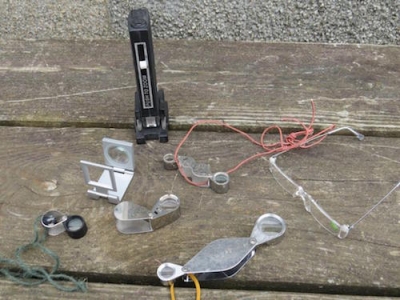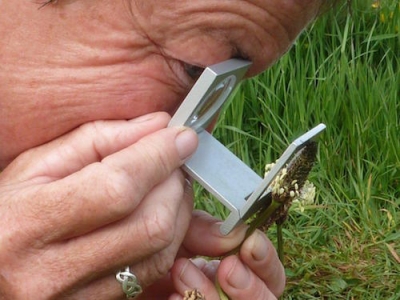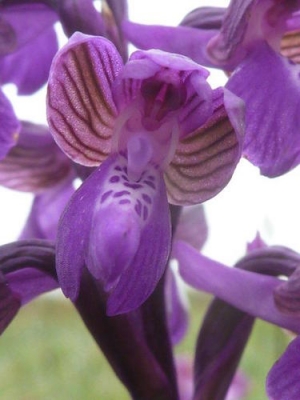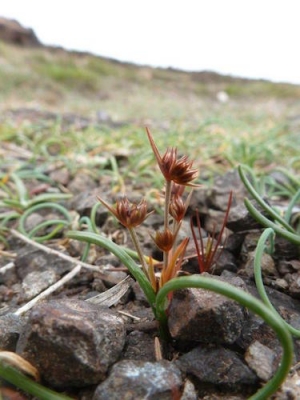What a fabulous time to be out and about investigating our rich and varied flora! Even if you are not interested in naming species, a hand lens is a portal into a fascinating microscopic world of architecture and form. A hand lens is a simple device, and here are a few thoughts about getting the most from this mind-blowing key piece of kit.
 |
 |
• Hand lenses are lightweight and relatively cheap. Therefore you can easily have it with you when you need it, and you can buy a quality one for only a small outlay ( both plus points compared to binoculars)
• When out and about keep it on a piece of string around your neck – you will always know where it is and will never leave it behind.
• Hand lenses are generally better than lollipop type magnifiers – they give a better image and greater magnification, though the Sherlock Holmes type can be useful if you want to look at a wider area. You will come across doublet and triplet hand lenses – this means that the magnifier is made of two or three separate lenses giving enhanced quality. A doublet is adequate for botanising.
• A good case. When not in use, a hand lens pivots into an attached, protective post-and-plate case. If the case fits snugly— it's easy to pivot the lens in and out, but it then stays put—and if the case is made of some sturdy, corrosion-resistant material (chromed brass or hard plastic, for example), then you've got a good case.
• Reasonable Magnification Power. Too little power (3x or less) is just too little. A hand lens is a magnifier. Too much power means too small a field of view, as well as too short a working distance. Ten power (10x) is a good compromise. It's high enough to be useful, but low enough to let you stand back. Sometimes you may need higher magnification especially if looking at mosses and liverworts for example - but then maybe you would be better off with a microscope? Focal distance is the distance at which you must hold the subject in front of the lens for it to be in focus.  Notice in the photo that the flower is about an inch from the front of the hand lens. This is a 10x hand lens. It magnifies 10 times, and one inch is the focal distance. The higher the magnification, the shorter the focal distance and the smaller the "field of view" or the area of the subject that you will be able to view. So, with a 20x hand lens (very difficult to use!), the focal distance is only 0.5 inch. Keep this in mind when purchasing a lens. For most nature study purposes such as tree identification, wildflower study, and examination of insects and rocks, 10x is an excellent magnification.
Notice in the photo that the flower is about an inch from the front of the hand lens. This is a 10x hand lens. It magnifies 10 times, and one inch is the focal distance. The higher the magnification, the shorter the focal distance and the smaller the "field of view" or the area of the subject that you will be able to view. So, with a 20x hand lens (very difficult to use!), the focal distance is only 0.5 inch. Keep this in mind when purchasing a lens. For most nature study purposes such as tree identification, wildflower study, and examination of insects and rocks, 10x is an excellent magnification.
• Optical quality. Go for glass not plastic – they give a clearer image and don't scratch so easily. Like binoculars, the best test of a hand lens is side-by-side comparison with several others. Failing that, the next best thing is an extended, critical trial. A good lens will have a crisp, bright image. It won't distort colours or create rainbow halos around objects. Finally, it will have a broad, flat field. Straight lines will look straight. Distortion, even at the edges of the field where it's always most noticeable, will be slight.
• Illumination. It is possible now to buy lenses with a built in LED lamp to illuminate your subject – handy, but not essential, and a little bit bulkier.
 |
 |
• How to use – often people who have never used a hand lens will begin looking at them by holding the instrument out at arm's length. You get the best view of the subject by holding the lens as close to your eye as possible and bringing the object up in front of the lens until it is in focus (see picture). This might be a little bit difficult to get used to if you have not done it this way before, but with a little practice, you will find that you get absolutely the best view of the subject. Welcome to the wonderful world of the small!!!
Published: June 2015
Author: SteveTownsend (NE, Reserve Manager, Lizard National Nature Reserve)
